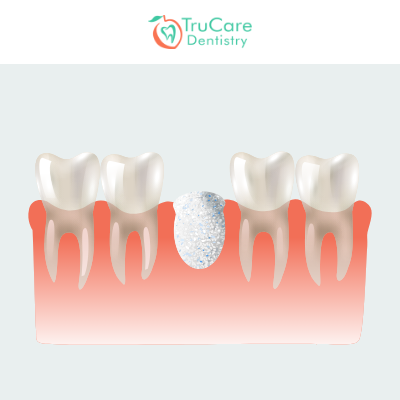
Perhaps, you have reached the blog as you plan to undergo a dental bone graft procedure. Yes, it’s a minor process. But you are indeed doing the right thing by gathering information and preparing yourself for the treatment.
Dental experts at TruCare Dentistry perform the surgery before dental implant placement. We have created this blog based on inquiries about the procedure that our surgeons answer frequently.
What’s dental bone grafting?
Dentists use bone grafting material to replace areas of the missing jaw bone. The process promotes the regeneration of natural bone. The material is absorbed well by natural bone as it regenerates.
A bone graft helps patients by preventing many long-term complications. In addition, it improves muscle tone and helps stabilize the jaw.
Most surgeons prefer the autograft dental bone graft material. Yet, your dentist may choose one of the other options like allograft, xenograft, alloplastic, or ceramic-based grafts. The type of material required differs depending on the affected area.
When do dentists recommend the procedure?
Certain restorative dental fixtures, including implants, require sufficient bone mass support. Thus, dentists perform a dental bone graft in case of an insufficient foundation. Research has highlighted that a considerable number of patients need to undergo the process to replace missing teeth in the US.
Dental surgeons sometimes realize the need for dental graft only after creating an incision in the gum for placing a dental implant. In such a scenario, they might perform a bone graft then get back to the implant procedure once the bone regrows.
Dentists recommend the surgery in case of the following complications:
- Creating support in the jaw for dental implants
- Gum disease treatment
- Problems in speaking or eating post tooth extraction
- A slump in facial muscles
- Wrinkles on face
A quick look at bone graft procedures
Block bone graft, socket graft, and sinus lift are three procedures.
Block bone option is often recommended for patients with severe bone loss. As the name suggests, a socket loss graft is performed post tooth extraction to avoid bone loss. In addition, it helps in preparing the site for an implant after a couple of months. The third type, sinus lift, is performed after extraction of upper molars to avoid sinus areas from moving downward.
A glimpse into the surgical procedure
Dentists require anywhere between 20 to 90 minutes to conduct the surgery.
The first stage involves a detailed oral examination. Next, dentists use scans and X-rays to pinpoint the affected areas and the extent of bone loss. Experts create a personalized treatment plan based on the results. Surgeons may prescribe antibiotics in case there are signs of infection.
Before starting the surgery, a local anesthetic is administered to numb the area. Then, a vertical incision is created in the gums to access the jawbone. Next, the portion is disinfected and cleaned. After that, it is filled with bone grafting material and covered with a thin collagen sponge (membrane). The final step involves repositioning the gum tissue and closing the incision with stitches.
Healing process
As mentioned earlier, an anesthetic ensures patients do not experience discomfort during the procedure. In addition, dentists prescribe medications to handle swelling and pain post-procedure.
The healing process takes between four to six months. It’s crucial to note that the time frame varies on a case-to-case basis. Dentists schedule a weekly or by-monthly check-up post-operation.
Most professionals use dissolvable stitches. If not, they will schedule a separate appointment to remove them during the healing phase. Digital radiographs help dentists check the recovery of the operated sites in various stages.
Aftercare
It’s vital for the patients to take care of eating and drinking habits during the recovery phase. Dentists recommend soft food or a liquid diet for a few days post-process completion. It will help if you remain ready to stay away from hard and crunchy foodstuff for a few months. Don’t consume hot liquids like soup, coffee, tea until advised by the doctor.
Avoid participating in sports or any strenuous activities during the recovery period. Also, keep your head elevated while sleeping.
Do you smoke cigarettes? If so, you might need to quit smoking a few days before the surgery and during the recovery time frame. Avoid chewing tobacco and consumption of alcohol as well.
Are there any risks associated with dental bone graft surgery?
Patients may experience mild bleeding, skin or gum swelling at the operated site. But remember, symptoms are minor and remain for a brief period.
Dentists place a gauze packing in the mouth. They might share instructions for changing the same post 24 hours. Ensure you take the antibiotics, including painkillers, to avoid infection at the operated site. Failure in doing so can result in complications.
Experienced surgeons complete the surgery quickly. It’s certainly not too invasive. The success rate for dental bone graft procedures is impressive. However, chronic smokers and individuals with certain medical conditions are high-risk patients.
You should immediately contact your dentist if you notice pus or another fluid leaking from the bone graft site. Also, continuous pain and swelling even after the first-week post-operation deserves immediate attention. Other signs of surgery failure are gum recession and lack of jawbone volume improvement even after weeks.
To conclude:
Modern dentistry has considerably reduced the discomfort associated with dental procedures. Healing takes time, but patients start feeling normal within a week after undergoing dental bone graft treatment.
Are you searching for a dental bone graft specialist in Roswell (GA)? Get in touch with TruCare and fix an appointment. Let’s get your dental health back on track.
